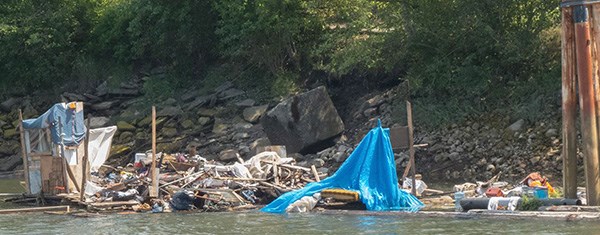Take a walk or boat ride along the Mamquam Blind Channel and piles of what looks like garbage can be seen along the shoreline.
Much of that debris belongs to one or more homeless residents who use the wood, metal and Styrofoam to form makeshift sleeping huts or to burn for cooking or heat, according to Squamish RCMP.
Also along the waterfront are tents and vehicles in various states of disrepair where people live. The piles of debris and vehicles are unsightly to some who take to the Internet to voice their concerns.
Mayor Patricia Heintzman told The Squamish Chief it is a complicated and sensitive issue for the district.
“We want the environment to be clean and healthy, and we want it to be safe and people to feel comfortable,” she said. “It is an important thing to make sure that it is an inviting place for everybody.”
According to Lisa Young, homeless prevention and outreach worker with Sea to Sky Community Services, some people in the community who have amassed debris have been offered community resources but don’t want assistance.
“If there is somebody in town who is in need of support services in this town, we help them to the best of our ability, as much as they want to be helped,” she said.
For squatting and other illegal camping, Heintzman said the district can act only if it is happening on its property.
District bylaw officers attend to homeless camps and ask people to move along and give timeframes during which to move, she said. “We generally take a bit of a soft-handed approach. We don’t want to be bullying or putting people out, but obviously we will try to encourage them to use the services that are available, whether it is Helping Hands or homeless outreach through Sea to Sky Community Services,” she said. “These situations are challenging for everyone.”
Heintzman said how people are dealt with also depends on their situation.
“If it is a result of people just coming because they are here for the summer and they are climbing or mountain biking or whatever they are doing, we would direct them to proper campgrounds, if that is the case.”
Heintzman said she is mindful that there is currently a housing squeeze in Squamish.
“It does put a lot of pressure on that lower income range and the lower housing end of the spectrum because it starts pushing people out, and so I think with the current real estate demands we’re going to see those unintended consequences of potentially more homelessness or that type of thing,” she said.
There were about 288 unique stays at the homeless shelter in the past year, according to Maureen Mackell, executive director of the Squamish Helping Hands Society.
Mackell agrees that homelessness is on the increase in the district.
“I would predict that the very real and growing issue of a lack of affordable housing is what is driving the homeless numbers right now,” she said, adding that the society is going to soon do a homeless count throughout the district. “With our zero vacancy rate we have seen a sharp increase in the cost to rent anything in Squamish: a one bedroom is going for $1,200. Whatever the homeless numbers were in the last year… they will go up substantially in the coming year if affordable housing does not somehow become available.”
Young agrees the problem of homelessness is growing. She said in addition to affordable housing the district needs housing that accepts people addictions and mental health conditions, instead of requiring them to be clean and healthy before they are housed.
“Affordable, supportive housing for people where they are at,” she said.
Heintzman said homelessness is a focus of the housing task force and the solution is strong collaboration within the community.
“I am hoping we will start to chart a very proactive and forward thinking homelessness strategy with the thought that we are a community of the size that we can solve this puzzle and actually end homelessness in Squamish,” she said.



